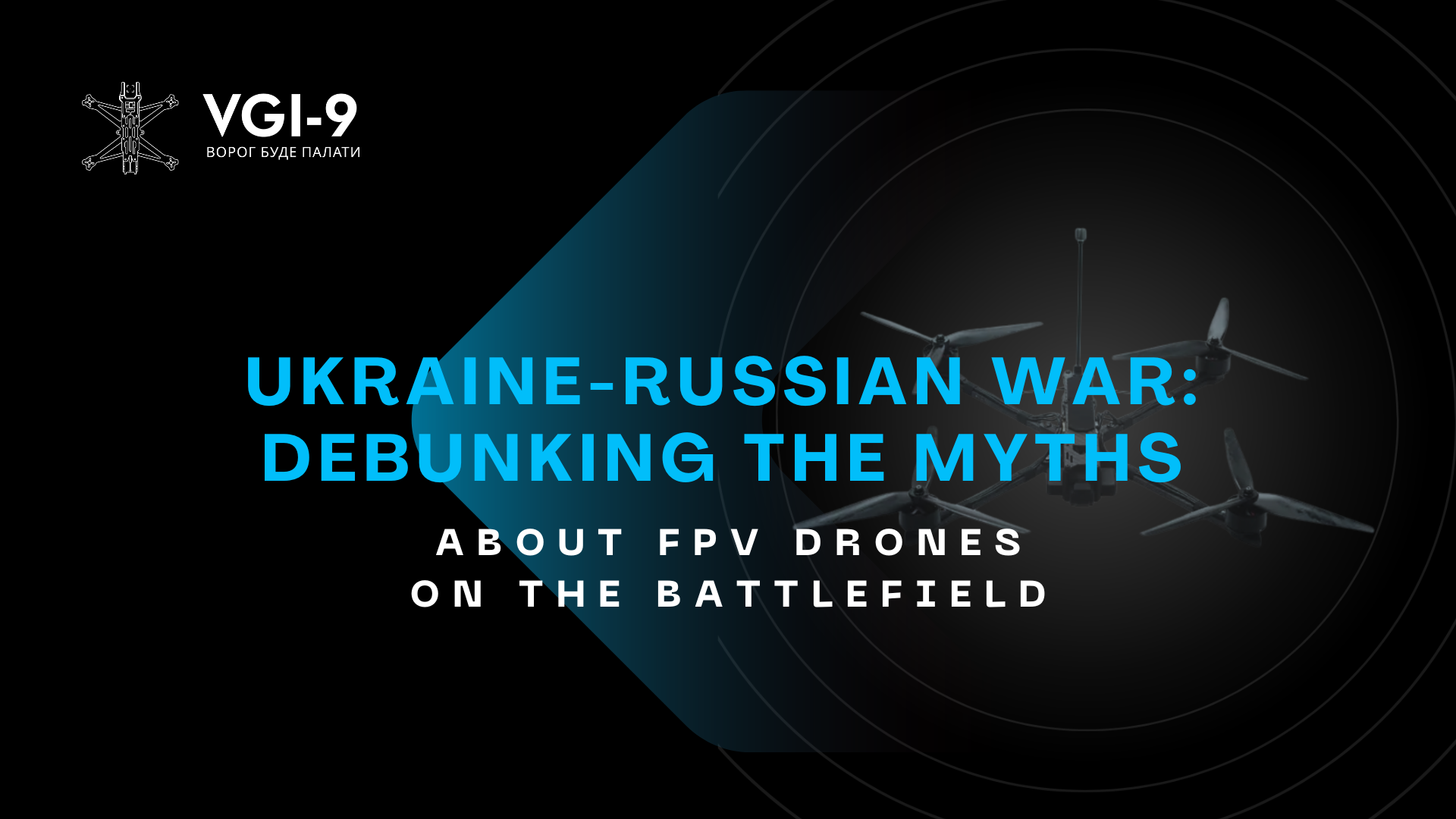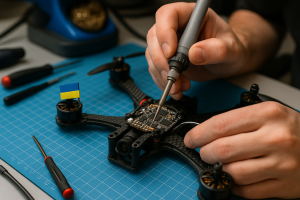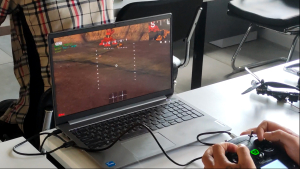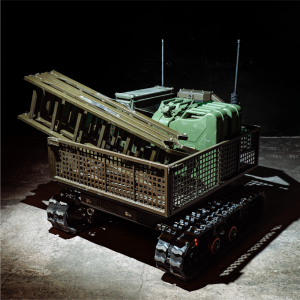The Russian-Ukrainian war has fundamentally transformed the way modern warfare is conducted. For the first time in history, heavy weaponry and armored vehicles no longer guarantee dominance on the battlefield. Instead, unmanned systems — agile, accessible, and high-tech tools for reconnaissance and strikes—have taken center stage.
FPV drones have become the symbol of this new era of warfare. They have drastically reshaped combat tactics and shifted the balance of power. According to The Wall Street Journal, Ukraine is now the world leader in FPV drone production. These drones carry out critical missions ranging from surveillance to direct attacks, striking enemy equipment with the precision of guided missiles.
Despite their growing importance, FPV drones are still surrounded by myths and misconceptions. Some people overestimate their capabilities, while others underestimate the impact they’ve had on modern combat.
Let’s break down the most common myths about FPV drones and separate fact from fiction.
FPV Drones: Defining the Term and Highlighting the Advantages of the Technology
FPV (First Person View) drones are unmanned aerial vehicles that stream real-time video directly to the pilot’s goggles or screen, creating an immersive, first-person flying experience. While originally used for racing, aerial photography, and freestyle flying, they are now widely adopted in military applications.
In the military sphere, FPV drones are gaining increasing popularity due to their undeniable advantages:
- Low cost: FPV drones are significantly cheaper than traditional combat systems.
- Scalability: they can be rapidly produced in large numbers thanks to their simple assembly.
- Small size and low flight altitude: these features make them harder to detect by radar.
- High manoeuvrability: they can operate effectively in tight or difficult-to-reach areas.
- Wide frequency range: this makes it harder to jam their signals.
- Remote control from a safe distance: pilots can operate drones without exposing themselves to danger.
- Versatility in targeting: capable of engaging both ground and aerial targets.
- Equipping the drone with various payloads, including explosives.
- Advanced features: such as remote detonation, autopilot modes, or drone homing systems.
- Extended flight range using a “mothership drone”.
As a result, FPV drones have become an indispensable tool in military operations. They are used for reconnaissance (flying at low altitudes to evade electronic warfare systems and equipped with thermal imaging for night missions); for fire adjustment (relaying real-time information on enemy vehicle movements to help artillery strike with precision); and as kamikaze strike drones (capable of destroying enemy infantry, fortifications, armored vehicles, and logistical centers).
Why So Many Myths Surround FPV Drones
1. A relatively new technology.
FPV drones only began to see widespread military use in the last few years, especially during the war in Ukraine. Many people simply haven’t had time to fully understand how they work or what they’re capable of.
2. The “Hollywood effect.”
Movies and video games often exaggerate the capabilities of drones or oversimplify how they function, creating unrealistic expectations.
3. Lack of technical knowledge.
People unfamiliar with electronics, FPV systems, or electronic warfare (EW) may either overestimate or underestimate what these drones can really do.
4. Disinformation.
In times of war, both sides may intentionally spread false or misleading information to confuse or deceive the enemy and the public.
5. Rapid technological changes.
FPV drone technology is evolving fast. What was true a year ago might already be outdated or completely inaccurate today.
With that in mind, let’s break down the Top 7 most common myths about FPV drones.
Myth 1: FPV Drones Can Replace Artillery and Missiles
While FPV drones have become a powerful tool on the battlefield, they are not a full replacement for artillery or guided missiles.
Most FPV drones have an operational range of just 5 to 15 kilometres, whereas artillery and missile systems can strike targets tens or even hundreds of kilometres away.
FPV drones carry a relatively small explosive payload, making them not ideal for destroying fortified structures, large depots, or command centres — tasks better suited for heavy missile strikes.
Unlike satellite-guided missiles, FPV drones require constant communication with a pilot, which makes them vulnerable to electronic warfare (EW). They’re also less reliable in poor weather conditions like strong winds, rain, or snow, whereas artillery and missiles can operate effectively in almost any environment.
What Is the Role of FPV Drones?
FPV drones are not meant to replace artillery or missiles — they are designed to complement them. These drones are highly effective for localised missions, such as destroying armoured vehicles, hitting precise targets in urban areas, or striking moving objects.
In modern warfare, gaining an edge on the battlefield depends on the synergy between FPV drones, artillery, and precision weapons, with each playing a distinct role. Today, core ground operations—like troop deployments, assault missions, securing positions, or repelling attacks—are almost unimaginable without the support of FPV drones.
There is hope that the Ukrainian army will continue evolving at a rapid pace, and that outdated mindsets will fade — especially among commanders who still attempt to conduct operations without incorporating drone technology. The future of warfare demands adaptation, and FPV drones are already at the heart of that transformation.
Myth 2: It’s Too Difficult for Older Generations to Learn How to Operate FPV Drones
While flying an FPV drone does require practice, modern training tools—especially flight simulators—make the learning process much more accessible, even for older individuals.
There’s a wide range of drone simulators available, including advanced versions that simulate real combat scenarios, like targeting enemy vehicles or infantry. Some even replicate the feel of carrying a payload, helping pilots get used to handling drones in realistic conditions.
With around 100–150 hours of practice in a simulator, most people can gain enough skill to fly a real FPV drone. The key to successful operation isn’t speed — it’s about focus, precision, micro-control, and smooth manoeuvring.
Levels of FPV Drone Control Difficulty
1. Beginner Level
- Flying in assisted mode, where the drone automatically stabilizes itself
- Learning to make smooth movements and maintain altitude
2. Intermediate Level
- Transitioning to partial stabilisation
- Practising turns, altitude changes, and adjusting speed
- Flying in open spaces and learning basic manoeuvres
3. Advanced Level
- Full manual control without automatic stabilisation
- Performing stunt manoeuvres, flying around obstacles, and targeting enemies
- Reacting to unpredictable conditions like electronic warfare (EW), wind, or signal interference
Additionally, VGI-9 has developed a specialised drone training system by integrating its advanced targeting technology into a flight simulator. In collaboration with the FPV Schools Association, this simulator is now being distributed to educational institutions.
This innovation enables military personnel to practice operating drones in a realistic virtual environment before transitioning to live missions. It allows them to rehearse complex combat scenarios, build precision skills, and minimise risks to both equipment and human life.
Myth 3: Drone Automatic Targeting Systems Are Still Experimental
Today, many military personnel remain somewhat sceptical about drone targeting systems, largely due to past negative experiences.
“The widespread adoption of automatic targeting systems was slowed by the negative impressions formed in late 2023 and early 2024, when a surge of teams rushed to present their solutions. Unfortunately, many of these offerings were incomplete and not truly ready for operational use. Frankly, a lot of startups showcased prototypes rather than finished, battlefield-ready products”, explains the Chief Technical Officer of VGI-9.
However, the situation has improved significantly. Now, there are several high-quality solutions available, which are gaining attention among both military and volunteer communities.
This technology is gradually— perhaps not as quickly as we would like — but steadily gaining popularity, especially among military units and security forces seeking to enhance the precision and effectiveness of their drone operations.
Currently, most FPV drones are operated manually, without GPS navigation or autonomous systems. While some FPV drones may include basic stabilisation aids, they are nowhere near the capabilities of full military-grade systems.
With the VGI-9 drone targeting system, the process becomes far simpler and more precise. The operator identifies the target, locks a marker onto it, and presses a button. From there, the system automatically tracks and engages the target with high accuracy, regardless of signal stability, wind direction, or weather conditions. The VGI-9 system can lock onto targets of any size, type, or location.
One of the key advantages of the VGI-9 drone targeting system compared to similar solutions is its separation of software from the hardware platform (the microcomputer). This approach allows for continuous scaling of production.
“We are not tied to specific components or a particular drone manufacturer. Thanks to this flexibility, we can quickly upgrade and adapt our system to different conditions, new FPV platforms, and the current needs of the military, all without wasting additional resources. Our team was one of the first in Ukraine to introduce a targeting system that is now actively used by the country’s defence forces,” explains the Chief Technical Officer of VGI-9.
Another major advantage of the VGI-9 system is its user-friendly and intuitive interface, which is based on just two buttons: “lock target” and “cruise control.” Operators don’t need to manually configure drone weight, frame size, or contrast — the system handles these settings automatically.
Read the full interview with our company’s CTO to learn more automatic target guidance system VGI-9.
The trend of equipping FPV drones with targeting systems is expected to grow. VGI-9 predicts that soon, this feature will become a standard requirement when purchasing drones. They also anticipate an evolution of these systems, including greater detection range, autonomous target locking, and even the ability to engage airborne targets.
Myth 4: Ukraine is 100% Dependent on China for FPV Drone Production
It’s true that many FPV drone components—such as cameras, controllers, and motors—are manufactured in China. However, Ukraine is not fully dependent on Chinese supplies.
Ukrainian companies are actively developing domestic production of key components like drone frames, antennas, and power electronics. At the same time, efforts are underway to diversify imports, with FPV parts now sourced from Europe, the United States, Taiwan, and other countries.
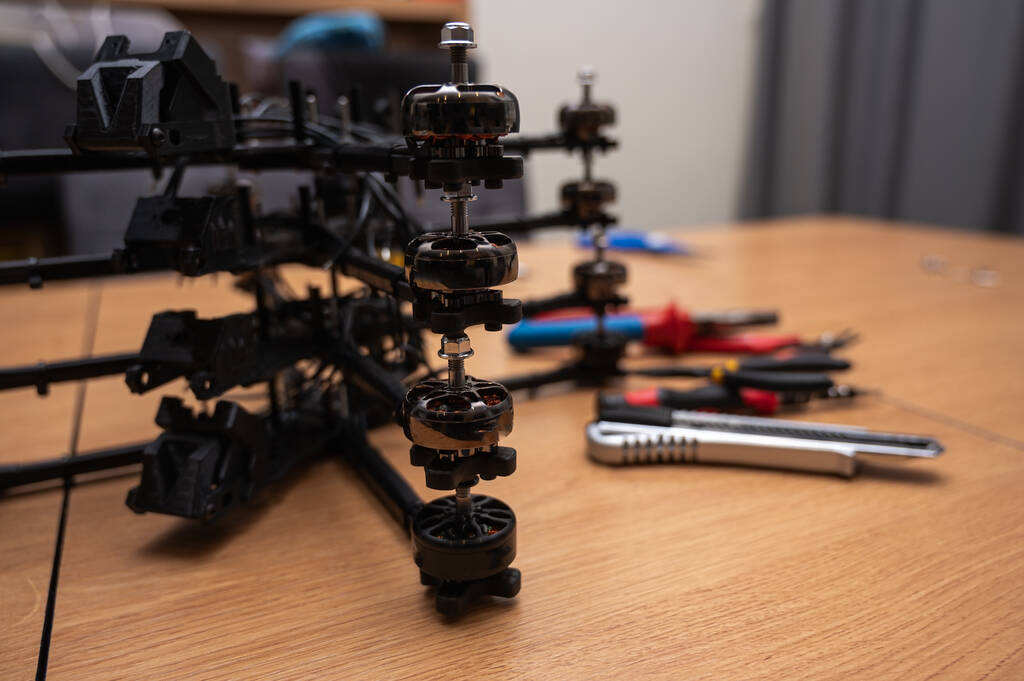
In parallel, Ukraine’s engineering sector is advancing. Local manufacturers are already creating Ukrainian-made navigation systems, electronic warfare-resistant communication modules, and autonomous technologies.
As a result, dependence on China is steadily decreasing, while Ukrainian innovations are gaining momentum, equipping FPV drones with homegrown technologies.
Myth 5: Ukraine Is Far Ahead of Russia in the Use of FPV Drones
While Ukraine was a pioneer in the mass deployment of FPV drones, Russia has also been actively developing this technology, establishing serial production with support from state resources and large enterprises. The technological rivalry between the two countries is intensifying: both sides are constantly refining their tactics, improving electronic warfare (EW) resistance, and extending drone flight ranges.
In particular, Russia currently has a significant lead in the use of fibre-optic-controlled drones. These drones first appeared on the battlefield in the early fall of 2024, targeting Ukrainian armoured vehicles. More recently, the Russian army managed to breach Ukrainian defensive lines in the Kursk region, largely thanks to the mass deployment of fiber-optic drones.
The development approach also plays an important role. In Ukraine, volunteers and private businesses are key drivers, rapidly introducing innovations and adapting to battlefield realities. In contrast, Russia’s production is more centralised and heavily reliant on state programs.
Despite its early innovative advantage, Ukraine must continue to accelerate production, expand its engineering capabilities, and adopt new technologies in order to maintain its leadership in the FPV drone sector.
Myth 6: FPV Drones Are Only Single-Use Weapons
While many FPV drones are indeed designed for one-way missions, a significant number — especially reconnaissance drones or those used for artillery spotting — return safely after completing their tasks.
Typically, one flight lasts around 20 minutes. To extend flight time, operators focus on reducing drone weight, selecting the right battery, planning routes with wind conditions in mind, and adopting the right flying style — namely, maintaining a steady cruising speed.
In addition, it’s possible to equip FPV drones with autopilot systems by using flight controllers, GPS modules, and specialised software.
What can autopilot do for an FPV drone?
- Automated takeoff and landing
- Automatic waypoint navigation
- Altitude stabilisation and maintenance
- “Return Home” function
- Emergency landing procedures
- Fully autonomous combat or reconnaissance missions
Many FPV drones already use a hybrid mode — a mix of partial autopilot and manual control.
Myth 7: FPV Drones Are Only for Military Use
FPV drones aren’t limited to military operations — they are widely used in sports, filmmaking, search and rescue missions, industrial inspections, and security. This means that soldiers who master FPV drone technology today will have valuable skills they can apply in many civilian industries after their service.
Examples of civilian uses for FPV drones include:
- Competitive racing and freestyle trick events, where pilots compete at high speeds and show off complex manoeuvres.
- Filmmaking and commercial video production, capturing dynamic shots for movies, advertisements, and action scenes.
- Search and rescue missions helping locate people in hard-to-reach or hazardous areas.
- Industrial inspections of bridges, power lines, pipelines, and buildings.
- Security and surveillance operations, such as patrolling large areas and monitoring crowds at major events.
Here are some real-world examples of FPV drones in action:
- Fighters from the National Guard of Ukraine’s “Typhoon” Special Unit, in cooperation with the 14th Assault Brigade, destroyed a Russian “Borisoglebsk-2” electronic warfare system — valued at $200 million — using FPV drones near Pokrovsk.
- The Drone Racing League (DRL) hosts international FPV competitions, where pilots race drones at speeds of up to 160 km/h (100 mph), offering spectators a VR-like experience from the drone’s perspective.

- FPV filming in major productions:
- Red Bull frequently uses FPV drones for extreme sports filming.
- In Netflix’s movie “Red Notice”, FPV drones were used to shoot dynamic chase scenes.
- FPV filming for YouTube and advertising – for example, the famous “One-Shot Bowling Alley” video.
- After the 2023 earthquakes in Turkey, FPV drones helped search through rubble for survivors.
- In Australia, drones were deployed to monitor the spread of devastating wildfires.
How is the role of drones changing in modern warfare?
UAVs are becoming a key element in combat operations. Whereas drones were previously used mainly for reconnaissance, today they are actively involved in direct strikes, electronic warfare (EW) countermeasures, and even strategic operations.
FPV drones are used for direct attacks, fulfilling the role of expensive guided missiles. They effectively destroy fortifications and equipment, forcing troops to change tactics and use more camouflage. Countermeasures such as jammers, interceptor drones, and air defense systems are being deployed, and autonomous, EW-resistant drones are under development.
A future technological trend is the emergence of drone swarms and AI integration. FPV drones are already beginning to operate more cohesively and autonomously, which significantly boosts their effectiveness.
Another trend is the reduction in the cost of warfare. FPV drones are significantly cheaper than missiles, reshaping military logistics.
What’s next?
Modern warfare is rapidly evolving into drone warfare, and countries that adapt to these changes faster will gain a tactical advantage. The near future will bring autonomous control systems, new types of FPV drones, and deeper AI integration into combat operations.
FPV drones have become a revolutionary weapon due to their affordability, effectiveness, and ease of use. Their role continues to grow, and in the future, we are likely to see autonomous AI-powered drone swarms.
Contact us to get detailed information about the VGI-9 drone guidance system.
Follow our updates on social media and YouTube – there you will find:
✅ Exclusive materials on the development, testing, and combat use.
✅ Useful analytical content on the war and the role of FPV drones in modern combat operations.
✅ The latest news and insights from the world of military technologies.
📌 Join us:
🔗 YouTube: VGI-9 on YouTube
📸 Instagram: We are on Instagram
🎯 TikTok: We are on TikTok



